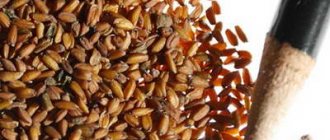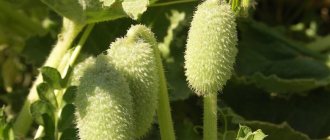Do you like arugula? If you are not familiar with the very healthy herb and its amazing delicate taste, go ahead! Spring is in full swing, there are fewer and fewer vitamins in the body and it’s time for good health to include young greens in the diet that have just come out of the ground, rich in useful substances. Arugula is a bright representative of it, which I discovered for myself quite recently.
Arugula (arugula) or caterpillar, wild mustard, indau sativum, eruka sativum - an annual or perennial herbaceous plant, a species of indau, of the cruciferous (cabbage) family. Grows in northern Africa, southern and central Europe; in Asia it is found from Asia Minor to Central Asia and India. In Russia it grows in the European part, in the foothills of the Caucasus and in the Kuban. Wild varieties of arugula are called caterpillar.
Brief description of the plant
Arugula is a compact plant 30-60 cm high with a slightly pubescent branched stem. Depending on the variety, the leaves can be either large and fleshy or medium-sized, thin and tender. Wild plants have narrower and elongated ones. The lower lyre-shaped leaves form a rosette.
Arugula is grown both in the southern regions and middle zone, as well as in places with a rather harsh climate.
Indau blooms in May-July with yellow or white flowers with purple veins. The shape of the flower is obovate, slightly notched. The plant is considered a good honey plant. The fruit is a sword-shaped pod, inside of which there are light brown seeds located in 2 rows.
Types and varieties of arugula
Types of arugula, or rather, its varieties, are annual and biennial. The root of biennial arugula tolerates winter well and produces juicy greens in the spring. The most famous of the biennials is arugula Solitaire - a mid-season variety up to 20 cm high with medium-sized lyre-shaped dissected leaves with cuts along the edges. The ripening period of this variety is 35-45 days, the taste is nutty-mustard.
Among the annual varieties, the following are popular:
- Dikovina is a mid-season variety up to 20 cm high with lyre-shaped leaves. This arugula ripens within 22-25 days;
- Cupid's arrows are also a mid-season arugula, 20 to 30 cm high, with long narrow leaves and light yellow flowers, ripening in 35-38 days;
- Olivetta is an early arugula 15-20 cm high with juicy leaves of mustard-nutty taste, rich in carotene, vitamins and essential oils. Ripening time 20-25 days;
- Rocket is an early ripening variety 15-20 cm high with pinnately dissected leaves of a dark green color with a nut-mustard taste, ripening in 20-25 days;
- Poker is an early variety up to 20 cm high with large leaves with a sweet mustard flavor and pale cream flowers. Ripening period – 22-28 days;
- Victoria is a variety with short, abundant greens of dietary taste, rich in vitamins, ripening in 20-25 days;
- Spartak is also an early dietary variety, up to 22 cm high, with spicy greens rich in vitamins and essential oils, which can be cut after 20-25 days.
The arugula varieties Sicily, Corsica, Euphoria, Taganskaya Semko and Rococo are also popular.
Timing for sowing arugula seeds in open ground
Indau seeds are sown in open ground in April and August. The plant loves warmth, so when planting in spring you should wait until the air temperature reaches 8-10 degrees. Under favorable weather conditions, the sprouts hatch already 3-5 days after sowing the seeds.
Returning cold will not damage young seedlings, since indau without shelter tolerates short-term frosts down to -6 degrees.
Arugula should be sown in August when the summer heat subsides. For western regions this is the first ten days of the month, for more southern regions it is the second and third. Experienced gardeners note that greens planted in spring have more juicy, crunchy leaves. When planted in autumn, the green mass is more voluminous, but not as juicy.
How to grow arugula
Lettuce can be grown in two ways - in greenhouses and open ground.
In greenhouse conditions
Since the land is protected, this will ensure a whole year of arugula harvest.
An important condition for a greenhouse is temperature. The pointer should not fall below 16 degrees
If sunny days are far behind, the salad needs artificial lighting using special lamps.
Preparing the soil before sowing:
- Carry out the loosening procedure to a depth of 20 cm.
- Clear the beds of weeds and residues of other crops.
- After 12 days, do plowing. In this way, it will be possible to destroy weeds that have entered the deeper layers of the soil.
- Carry out harrowing. This allows moisture to remain in the soil for a long time.
At first glance, it may seem that the pre-sowing stages are complicated, but this is not so. If you follow the instructions, a person will succeed. As a result, seedlings will appear, and eventually an adult crop.
Open ground
Many gardeners and summer residents practice this particular method of growing crops. Lettuce seeds are sown from mid-spring to the end of August. The procedure is repeated every 10 days to always have fresh greens. If summer days are very hot, choose an area that is in the shade. Arugula does not tolerate direct sunlight.
The procedure for sowing seeds in open ground is the same as in greenhouse conditions. It is recommended to follow these rules:
- the distance between rows should be within 45 cm;
- deepen the seed material into the soil no more than 1.5 cm;
- there should be at least 5 cm of free space around the plant.
The density of sowing negatively affects the growth of each bush. Excess sprouts are removed when they have 2 leaves.
Obtaining seedlings
Growing by seedlings is also possible. To do this, take individual cups or a large pot. In the latter case, 30 pieces are sown. 2-3 seeds should be planted in each glass to select the strongest sprout and transplant into open soil.
Shoots appear very quickly. When the seedlings are strong enough, they are transferred to a permanent place in open ground along with a lump of earth. For normal development, a temperature of 9 degrees is sufficient. To protect young seedlings from the cold, the sprouts are covered with jars and removed in the morning.
Growing on a windowsill
An excellent alternative for city dwellers who do not have land. If there is a balcony, this is only a plus, since pots of herbs can be taken out into the fresh air. It is recommended not to plant many sprouts in one box. It is better to choose only one container for each bush. A special requirement that a person must comply with when growing arugula on a windowsill is in a box - its depth should not exceed 10 cm.
Rules for planting plants in the garden
The plant does not tolerate too much sun, so you should not choose open areas. The ideal option would be an area where it will be sunny before lunch and scattered shade in the hot afternoon hours.
Arugula is not picky about soil, but grows better in areas with light, well-fertilized soil with a neutral reaction. Acidic clay soils are not suitable for planting salad greens, so they must first be deacidified with lime.
You should not choose areas with high groundwater levels, since waterlogging of the root system significantly increases the risk of fungal diseases.
Seed preparation
In order to get healthy indau shoots after 5 days, the seeds should be prepared in a certain way before sowing. By purchasing seed in specialized stores from well-known manufacturers, you can be sure of their quality. Most often, they have already been processed, so there is no need to disinfect them.
Some gardeners prefer to buy seeds secondhand at the market or from neighbors. In this case, they must be disinfected. Pre-sowing treatment of seeds is carried out using a 3% solution of hydrogen peroxide:
- heat the peroxide to 40 degrees;
- pour the solution over the seeds for 7-10 minutes;
- drain the solution;
- dry the seeds on a napkin.
If the quality of the seeds is suspect, they can be germinated before sowing:
- soak the seed in Epin solution for 2 hours;
- place the seeds on a damp cloth and wrap;
- place the package in a container and close it with a lid;
- put the homemade greenhouse in a warm place.
With this method of germination, the seeds will hatch within a couple of days, after which they can be sown in the soil.
Soil preparation
The soil in the area where arugula will be planted has been prepared since the fall. First, dig up the area well and remove the weeds. Add 3 kg of compost, 15-20 g of potassium chloride and 20 g of superphosphate per square meter to the soil. m. Dig up the area again and water it with water.
In early spring, urea is added to the soil at the rate of 15 g per square meter. m. In areas with high soil acidity, it is necessary to add 300-500 g of quicklime per square meter. m for deoxidation. Immediately before planting, the soil is loosened and leveled.
Scheme for planting arugula in open ground
The scheme for planting arugula in open ground is not much different from the methods of sowing any other greenery:
- In the prepared area, make grooves no more than 1.5 cm deep and water them thoroughly.
- Leave a distance between rows of about 30 cm.
- Sow the seeds at a distance of 5 cm from each other.
- Cover the beds with soil and tamp it down lightly.
- If there is a high probability of return frosts, cover the crops at night with film, remembering to remove it during the day.
Good and bad predecessors
Arugula is best grown after vegetable crops such as potatoes, peas, pumpkins, carrots or tomatoes. It is not recommended to occupy beds where radishes, turnips, cabbage, and horseradish previously grew for planting greens. The arugula should be returned to its original place no earlier than after 4 years.
Beneficial properties and harm
The product is useful for:
- Gastrointestinal tract;
- nervous system;
- vessels;
- genitourinary system;
- skeletal system;
- blood.
When you introduce arugula into your diet, the following happens:
- Cleansing the body of toxins. A brush made of swollen dietary fiber cleanses the intestines, removing accumulated harmful substances from it.
- Decreased appetite to normal levels. Dietary fiber, swelling in the stomach, fills it, which causes a feeling of fullness and prevents overeating.
- Improving the condition of blood vessels and blood. Blood sugar levels decrease and cholesterol plaques dissolve.
However, the use of arugula is limited in cases of kidney and liver dysfunction, as well as in the presence of the following diseases:
- gastritis;
- stomach ulcer;
- increased acidity level.
The abundance of phytoncides in the herb can provoke allergic reactions in the form of:
- skin redness;
- mild itching;
- bitter taste in the mouth.
In case of hypersensitivity to the components, the daily dose of the herb is limited to 25 g.
For women's health
For representatives of the fair sex, this salad herb is recommended for strengthening nail plates and hair follicles.
In cosmetology, the plant is used to whiten freckles and age spots. To do this, arugula juice is applied pointwise to the problem area.
Pregnancy and arugula consumption
Salad grass can be eaten in small quantities during pregnancy and breastfeeding. However, large portions, more than 500 grams per day, of the plant can lead to increased uterine tone.
Vegetarian pizza with parmesan and arugula
For men's health
In ancient times, arugula was considered an aphrodisiac. To enhance erectile function, men consumed this product by mixing it with honey and black pepper.
Caring for arugula after planting
Arugula is an unpretentious plant, so if planted correctly, you will not need to spend too much time caring for it. All you need to do is provide the young greenery with abundant watering, regularly remove weeds and loosen the soil.
After the emergence of seedlings, it is necessary to thin out the plantings. When 2 true leaves appear, remove excess shoots, leaving a distance of 5-7 cm. Carry out the next thinning at the stage of formation of 4 true leaves. The distance between future bushes should remain about 15 cm.
Temperature
The optimal temperature for the development of indau is 18-20 degrees. At lower thermometer readings, the plant slows down its growth and development, and the growing season is significantly extended.
When prolonged frosts occur, it is necessary to immediately build a shelter made of plastic film or any other covering material over the beds.
Too high an air temperature also negatively affects the growing season of the plant. Bushes may bloom prematurely, especially varieties that are not resistant to bolting.
In addition, increased temperature during the active growth of green mass leads to a decrease in its taste. Arugula leaves lose their juiciness, become rough and tasteless. This problem can be solved by stretching a special shading film over the area.
Watering
Arugula is a moisture-loving plant, so it requires frequent, abundant watering. The soil in the root area should always be moist, but the water should not stagnate. The plant does not tolerate waterlogging. In regions with hot summers, watering is carried out daily, in cooler conditions - 3-4 times a week.
With a lack of moisture, indau leaves become bitter and become unsuitable for consumption.
Weeding and loosening
In order for oxygen and moisture to better penetrate the root zone, the soil around the bushes must be loosened regularly. It is easier to do this immediately after watering, using a hoe or a horn. An obligatory measure is the removal of weeds, which thicken the plantings, and some also negatively affect the taste of salad greens.
Try to remove weeds by the roots, otherwise they will soon appear again. If you are not a frequent visitor to your summer cottage, mulch the beds with hay or grass. This will not only inhibit the growth of weeds, but will also help retain moisture in the root zone longer.
Top dressing
When it comes to the need to fertilize arugula plantings, experts have different opinions. The fact is that the plant quite actively absorbs nitrates and other substances harmful to humans from the soil. Since indau has a short growing season, accumulated toxins do not have time to fully decompose.
If you prepared the area in advance before planting greenery, then the applied fertilizers will be enough for a bountiful harvest. On poor soils with poor bush development, you can use a solution of chicken manure in a ratio of 1:10 for feeding.
Growing arugula at home
How to grow homemade arugula
If you want to have fresh herbs on your table all winter, you can grow arugula on your windowsill. Sowing of seeds is carried out in slightly alkaline or neutral soil, which is prepared according to the following recipe: two parts of turf soil are mixed with two parts of humus and one part of sand. Do not forget to disinfect the soil mixture in the oven or pour boiling water over it before sowing the seeds.
You can sow in a box or container, but arugula in a pot will not only allow you to get vitamins to your table in the middle of winter, but will also decorate your home. Fill a container with drainage holes 2-3 cm with expanded clay, pebbles or broken bricks, then fill it with a damp substrate, level and lightly compact its surface, and then spread the seeds over the surface of the substrate, as when sowing seedlings.
Watering arugula
Growing arugula in an apartment will require you to constantly maintain the substrate in a slightly moist state, for which you should water the seedlings once every two days. Moisten the arugula using a fine spray. If plants lack moisture, their leaves become bitter. Do not forget to lightly loosen the surface of the substrate around the seedlings. A week and a half after the emergence of seedlings, you need to thin them out, removing weaker and smaller specimens that can be used for salad. Homemade arugula grows best at 18 ºC.
Fertilizing arugula
When grown in rich soil, arugula can do without fertilizers, but experienced gardeners insist that the plant still needs nitrogen fertilizing. Fertilizers are applied during watering: 10 g of fermented cow or chicken manure diluted 10-15 times with water is added to a bucket of water and mixed thoroughly. Since the ripening period of arugula is short, it is undesirable to fertilize it with manure or introduce mineral fertilizers, since the leaves of the plant can accumulate toxins.
- How to grow seedlings in bottles without soil
What is wrong with arugula?
Arugula is susceptible to some fungal diseases, especially if the plant does not receive proper care. The main ones are:
- Fusarium. The diseased plant begins to become chlorotic, then whitish spots appear on the leaves, and turgor decreases. Over time, the leaves begin to dry out, the stem darkens, and the above-ground part dies off completely. Fusarium cannot be cured, so the affected bushes are removed and burned.
- Downy mildew. The occurrence of a fungal disease is indicated by the appearance of red-brown dry spots on the upper part of the leaves. Below you can see a faint powdery coating. The leaves wrinkle and dry out. Fungicide treatments do not give the desired result, so the affected bushes should be removed.
- Verticillium wilt. The fungus enters the plant through small cracks, which often form after damage to the roots during loosening of the soil. In the initial stages, the disease does not manifest itself. During the period of active growth of green mass, yellow and whitish spots appear on the leaves, which quickly spread throughout the plant. The affected arugula bush can completely wither in 1 day. If you notice signs of disease, immediately remove the plant from the garden bed and burn it.
The essential oils present in the leaves of the plant repel many pests. But sometimes arugula can become a victim of cruciferous flea beetles and cabbage moths. The first can severely damage young greenery, leaving small holes on it. To combat the pest, plantings are covered with any garden non-woven material. As a preventive measure, you can sprinkle the bushes with wood ash.
Moths also love to eat fresh, spicy leaves. You can protect arugula from it using folk methods by treating the plants with wormwood tincture. To prepare it, grind the wormwood and boil for 10 minutes in a small amount of water. Cool and dilute with water in a 1:1 ratio.
Thin-leaved two-row
In the State Register of plant varieties suitable for distribution in Ukraine, there is only one variety of two-row thin-leaved plant - Gracia of Italian selection.
The Russian analogue contains 13 varieties, three of which were introduced in 2021.
Moskovskaya registered the mid-season variety Roket in 2006.
Rocket greens can be eaten after 28-30 days. The semi-raised rosette of leaves reaches a height of up to 60 cm and a weight of 15-20 g. The medium narrow leaves have a smooth surface, bright green color, dissected shape with teeth along the edge. The flower is light yellow. The greens have a strong aroma and a sharp mustard taste. Its yield is 1.5-2.5 kg/sq.m. m.
This early-ripening variety appeared in 2007 thanks to the Research Institute of Vegetable Growing on Protected Ground and Breeding and is quite popular.
Solitaire is a cold-resistant variety that can overwinter in open ground and produce greenery in early spring. Its ripening period is 25 days. The semi-raised rosette of leaves has a height of 18-20 cm and a plant weight of 15-20 g. The medium-sized leaves are green, lyre-shaped, with cuts along the edge. The flowers are yellow. The greens are very aromatic and have a strong nutty-mustard taste, the yield is 1.4-1.6 kg/sq. m. Can be grown by conveyor method during the summer.
Taganskaya Semko
The early ripening variety Taganskaya Semko was registered in 2006.
Greens are edible 20-25 days after sprouts appear. The semi-raised rosette, 15-20 cm high and weighing 20-25 g, consists of medium-sized dark green leaves with a smooth surface and serrated edges. The flower is light yellow. The greens have a strong aroma and pungent taste. Its yield is 1.3-1.5 kg/sq.m. m.
Registered in 2007 by the All-Russian Scientific Research Institute of Vegetable Growing.
Euphoria is a mid-season variety: 35-40 days pass from germination to the start of use. The plant is resistant to cold and drought, has a height of 23-25 cm and a weight of 30-40 g. The rosette of leaves is semi-raised. The smooth, wavy-notched leaves are green in color and medium in size, the flowers are yellow. Green yield – 3.2 kg/sq. m.
Cupid's arrows
The mid-season variety of Russian selection was included in the register of varieties in 2011 agro.
The plant retains commercial quality for a long time and bolts late. From germination to suitability for food, 35-38 days pass. The plant grows up to 20-25 cm in height. Weight – 35-38 g. The rosette of leaves is semi-raised, and the leaves are medium-sized, wavy-notched, green. The flowers are yellow. The yield of greens is 2.6-2.8 kg/sq.m. m.
This early-ripening variety of Russian selection appeared in 2011 thanks to.
“Wild arugula” Olivetta is distinguished by its rapid growth: in 20-25 days the greens can be consumed. It grows up to 20-25 cm in height, the plant weight is 20-25 g. The green, heavily dissected leaves have a pungent taste and strong aroma. Olivetta flowers are light yellow, the seeds are light brown, very small. The yield of greens is 1.3-1.5 kg/sq. m. Just a few years ago, arugula was a curiosity, but today seeds of many varieties are on sale, and this list will increase as breeding work is carried out and the greens market expands. If you are interested in growing a new crop or are a fan of arugula, you are sure to find a variety that suits your taste.
Harvesting greens
You need to cut young arugula leaves as they grow, choosing the widest and longest ones. Harvest regularly, without leaving the leaves on the bush too long, as they become tougher over time. The optimal length of a leaf that has reached ripeness is 8-10 cm.
After flowering begins, the taste of salad greens noticeably decreases. Some gardeners recommend removing the buds to slightly extend the harvest period. Arugula is consumed fresh, so it fully retains all its vitamins. Greens can be stored in the refrigerator for no more than 4 days.
The most suitable arugula varieties for growing
Arugula is a relative of cabbage. The leaves of this crop are used in the menu. They have a very refined taste. The taste is reminiscent of nuts with a slight bitterness. But the main advantage of the bush is its vitamin and mineral composition. This culture is especially rich in vitamin C. The leaves also contain vitamin B; the leaves contain flavonoids and phytosterols. Arugula is rich in micro- and macroelements. There are many varieties of it.
To choose the right variety, you need to refer to the characteristics of each plant individually.
Cupid's arrows look a lot like dandelions. The seeds give a stable harvest. During the ripening period, inflorescences of a light yellow hue are formed. These rudiments are relatively small in size. The bush can exceed 30 cm in height.
The size of the leaves of the Dikovinka variety reaches 20 cm. The stem of the crop is quite erect with a small edge. During the ripening period, small brown flowers appear. This variety has a slightly sweet taste to the leaves.
The Poker variety has large leaves. The bush is very fluffy. One rosette of green leaves can contain up to 26 pieces. The taste is slightly sweet with a slight bitterness.
The variety called Olivetta has the brightest taste. The height of the bush reaches 20 cm. The leaves are shaped like a lyre, slightly rounded towards the top. The main advantage of the plant is high productivity. It is easily transported over long distances.
Collecting arugula seeds
Long daylight hours and insufficient watering contribute to the fact that arugula quickly loses its color. By leaving a few flowering plants in the garden at the end of July, by the beginning of autumn you will be able to collect ripened greenery seeds. It is recommended to store them in glass containers or special Zip-Lock bags. The shelf life of indau seeds without loss of germination is 3-4 years.
Arugula is an easy plant to grow, requiring abundant watering and frequent loosening. If planted correctly, you will receive a rich harvest of spicy herbs without any additional fertilizing. By sowing seeds at several times, you will have a healthy vitamin salad on the table all summer.
0
0
Copy link
Arugula - what is it?
The plant belongs to the annual herbaceous plants of the cabbage family. The herb is native to the Mediterranean countries, although it is now widely used throughout the world. Arugula came to Russia recently—about fifteen years ago—and was immediately liked by many.
Of course, caterpillar tracks can now be bought in any supermarket, and they are relatively inexpensive. Why not grow it yourself on your own plot, or in a greenhouse, or even on a windowsill in winter? The plant is quite unpretentious, cold-resistant, so there will be no problems with cultivation. Look what indau looks like in the photo.
Rucola: how to choose, how to cook
When choosing this salad in a store, carefully inspect the product. The leaves should be fresh, green, juicy, but not yellow or limp. Also give preference to small foliage, this indicates that the plant is young. Only young arugula has that unique aroma and taste. The old one has worse flavor notes.
An interesting fact is that arugula seeds produce an oil that is almost identical to mustard oil. From the seeds you can also prepare “rucola” powder, which few people can distinguish from mustard powder, and as a result you can prepare homemade mustard.
Arugula is a herb, so it is advisable to consume it fresh. But it keeps well for 4 - 5 days in a paper bag in the refrigerator. A prerequisite is that it should only be sent to the refrigerator in a non-moist form.
Another great way to store arugula is in a vase like cut flowers. In a container with water and in the refrigerator, any greens perfectly retain their properties and appearance for several days.
Of course, like any greens, arugula is best added to various salads. But, my secret to you, it’s better not to cut it with a knife, but tear it into small bunches into shreds, and then add it to the salad. Then the arugula turns out much tastier. When you tear the grass with your hands, much more juice and aroma are released.
Summer arugula salad
- Arugula
- Spinach
- Carrot
- Onions or green onions
- Tomatoes
- Canned corn
You will need 1 bunch of arugula and spinach, 1 bunch of carrots and onions, 5 - 6 cherry tomatoes, or 2 large ones, 150 - 200 grams of corn.
Rinse the greens thoroughly and leave to dry on a towel. At this time, cut the carrots into strips and the onion into half rings, lightly fry them in oil in a heated frying pan until golden brown.
Tear arugula and spinach into a plate, add chopped tomatoes, corn, onions and carrots. Add some salt. Mix everything carefully. It is better to eat freshly prepared.
Salad with arugula, color. cabbage and rice
- 300 - 400 gr. cauliflower
- 100 gr. rice
- 1 onion
- bunch of arugula
- bunch of parsley
- bunch of dill
- 2 tbsp wine vinegar
- 3 tbsp olive or sunflower oil
- turmeric, ground paprika, salt, black pepper, sugar
- 1 apple (sour)
As usual, divide the cabbage into small inflorescences and cook in salted water until tender. Cook the rice until cooked, add salt and turmeric to the water at the tip of a teaspoon so that the color of the cereal turns beautiful yellow. Finely chop the parsley, dill and onion, and tear the arugula into small portions with your fingers. If desired, all the greens can also be torn.
Prepare the sauce: mix oil and vinegar, add a little paprika and sugar, and if desired, you can also add black pepper and salt. Cut the apple into slices.
Mix everything: greens, rice, cabbage, onion, apple. Pour red sauce over the ingredients and let soak for at least 20 minutes. The salad turns out very light, but at the same time satisfying.











